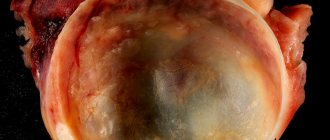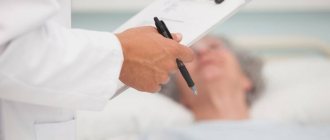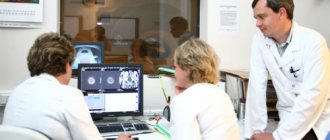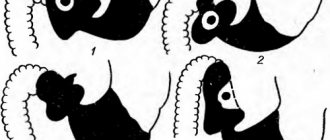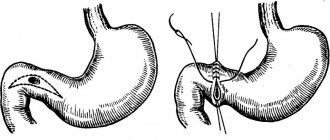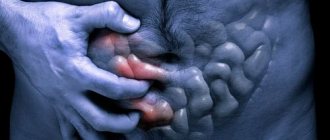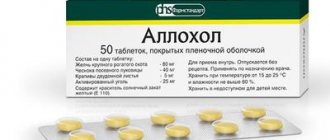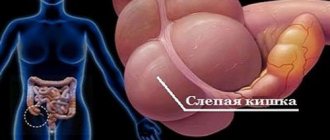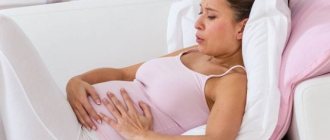Pain in the lower abdomen is a common symptom of damage to the intestines, urinary tract and internal genital organs. But they are not always accompanied by nausea, turning into the urge to vomit. More common signs of poor digestion are bloating, diarrhea, and general malaise.
If a woman or man has pain in the lower abdomen and feels nauseous, then you should carefully consider the possible causes, because they will be followed by serious illnesses with a possible transition to a chronic course.
Mechanism of formation of the syndrome
Pain in the lower abdomen is caused by signals from the intestinal loops (large and less often small), the bladder, prostate in men, and the uterus and appendages in women. It has been established that hollow structures cause pain impulses when the muscle layer contracts or overstretches, involving deep cellular connections in inflammation.
Because there are no pain receptors in the mucous membrane. Thus, pain appears due to problems in the bladder and intestines. More dense organs (prostate, uterus, ovaries) have an outer serous membrane with an abundance of nerve endings. They are sensitive to organ growth and swelling. The nature of the pain is constant and not associated with food intake.
Slow inflammation is always accompanied by the formation of external adhesions with neighboring organs. Their stretching causes nagging pain that intensifies with any movement.
A special mechanism develops when there are unpleasant sensations during pregnancy.
The woman feels that as the uterus grows, it constantly pulls downward, and there is a desire to urinate. This symptom is more pronounced during the first pregnancy and in physically unprepared expectant mothers. Caused by stretching of the uterine ligaments, pressure on the bladder.
Nausea can be described as a feeling of the possibility of vomiting, increased salivation. At the same time, sweating appears, breathing quickens, and swallowing movements increase.
Impulses form irritating toxins, products of one's own metabolism, hormonal fluctuations
It is caused by the stimulation of a special center in the medulla oblongata, a cluster of neurons called the “reticular formation”. Signals are received here from the receptor apparatus of the gastrointestinal tract, urinary and genital organs.
Nausea can be caused by smells, tastes, feelings of disgust, and increased intracranial pressure. An example of the influence of hormones is nausea during pregnancy. The vomiting center is designed to prepare a person for the cleansing action. He even reacts to the memory of unpleasant events and dishes. The spread of excitation to the vestibular apparatus causes dizziness.
On command “from above” in the body:
Bloating in the lower abdomen
- the tone of the muscles of the stomach and sphincter of the esophagus decreases;
- intestinal peristalsis almost completely stops;
- The tone of the duodenum increases significantly.
Impulses from the organs of the gastrointestinal tract go to the center along the sensory fibers of the vagus and glossopharyngeal nerves. To find out why the lower abdomen hurts and nausea, it is necessary to understand the reasons for the disruption of signals to the brain. We will get acquainted with the main diseases and their symptoms.
What hurts in the left lower abdomen and causes nausea?
The left iliac region is the projection area of the sigmoid and rectum. This is a favorite localization of diverticulitis, ulcerative colitis, and colorectal cancer. Digestion ends here, waste substances and toxins accumulate. When there is a delay in excretion, atony or mechanical obstruction, they are absorbed into the blood and cause intoxication, including the medulla oblongata.
A malignant tumor develops in the place where the highest concentration of harmful and toxic waste accumulates
Symptoms of inflammation:
- constipation followed by loose stools;
- the presence of mucus, blood, and pus in the stool;
- aching pain that becomes intense after eating and physical activity;
- weakness;
- moderate increase in temperature.
Patients refuse to eat due to increased abdominal pain and nausea, and lose weight.
In women, in addition to the intestines, the appendages are located on the lower left. Adnexitis (inflammation of the ovaries) causes constant bursting pain. They become sharp in the event of cyst rupture, leg torsion, apoplexy, or ectopic tubal pregnancy.
There is irradiation to the left side and back. These diseases contribute to hormonal imbalances, are accompanied by nausea, and women note that they feel dizzy. An attack of pain can cause a collapsed state and pallor.
Causes of pain
If you have pain in the lower abdomen and lower back
, this may be a symptom:
- the beginning of menstruation (may be normal);
- inflammatory process localized in the pelvic organs, including infectious ones (chlamydia, mycoplasmosis, gonorrhea, trichomoniasis, etc.);
- endometriosis;
- uterine fibroids or other pelvic tumors;
- hyperplastic conditions of the endometrium;
- adhesions in the pelvis;
- ovarian cysts;
- tuberculous lesions of the reproductive organs;
- increasing the tone of the piriformis muscle, located between the sacrum and the femur;
- incorrect location of the uterus - congenital or acquired due to weakening of the muscles of the abdominal wall;
- diseases of other organs located in the pelvis - intestines, urinary system, etc.;
- long-term sexual dissatisfaction and other conditions.
Diseases with right-sided localization
On the right in the iliac region in women, similar unilateral inflammations of the genital organs are possible, as on the left side. Here in persons of both sexes there is a vermiform appendix, the confluence of the jejunum and the cecum. Accordingly, according to the localization of inflammation, the diseases are called appendicitis and ileocolitis.
If everyone has heard enough about an attack of appendicitis, then ileocolitis is less common, but most affects the intestinal area in Crohn's disease. An attack of appendicitis begins with nausea, single vomiting, epigastric pain, and short-term diarrhea.
Gradually they move to the right lower abdomen and grow. A pulsating character, chills, and a rise in temperature indicate the formation of an abscess and a phlegmonous-gangrenous form.
With ileocolitis, inflammation covers the entire depth of the intestinal wall and breaks into the peritoneum or neighboring organs. The pain is very intense. The formation of local peritonitis, adhesions, and fistula tracts is possible. Intoxication causes nausea and fever.
If nausea bothers you with pain above the pubis?
The area in the center above the pubis and deep in the urethra is affected by inflammation of the bladder (cystitis), in men with prostate adenoma and prostatitis, in women with diseases of the uterus. These organs have pronounced innervation. The pathology causes constant excruciating pain in the lower abdomen and nausea, general malaise, and insomnia.
A benign tumor of the uterus (fibroids) causes heavy bleeding. Therefore, with prolonged course without treatment, women develop anemia, which further increases weakness and nausea. At the same time, fibromatous nodular formations are detected in the mammary glands, and it becomes necessary to exclude a malignant tumor of the mammary gland.
In girls and women, pain and nausea may accompany menstruation or the period of ovulation (in the middle of the cycle). They are caused by an abrupt growth of hormones, strong tone of the uterus, and often radiate to the lower back and sacrum.
Endometriosis is a serious precancerous disease. The proliferation of the epithelial layer in the uterus leads to the formation of “pockets”, niches in the muscle filled with blood and suppuration. Pressure and swelling create conditions for overirritation of nerve endings, pain and nausea.
Endometriosis spreads in multiple lesions to the tubes and ovaries
Chronic symptoms may begin after abortion or the use of intrauterine contraceptives. The development of sluggish adnexitis supports hormonal imbalance and affects uterine contractility.
In men, dull, constant pain above the pubis with irradiation to the coccyx, scrotum and anus is observed with prostatitis and prostatic hyperplasia. The enlargement of the organ impairs the patency of the urethra, so urination is delayed. Symptoms include:
- painful urges;
- pain;
- burning in the urethra;
- nausea.
Cancerous tumors of the uterus are accompanied by bleeding and anemia. When localized in the prostate gland or bladder, bright blood is seen in the toilet after each urination. Pale skin, weakness, dizziness, refusal to eat, and nausea appear.
Inflammation of the bladder develops more often in women. The infection comes from the anus through the wide urethral canal. The presence of a chronic process in neighboring organs (including damage to the vagina due to sexually transmitted and sexually transmitted diseases) supports cystitis and accompanies a long course.
Signs of exacerbation of the disease include:
- in strong pains and urge to urinate;
- pain above the pubis and in the perineum;
- irritability;
- insomnia;
- loss of appetite;
- nausea;
- temperature rise.
Treatment
Very common pain in the lower abdomen and lower back
turn out to be a symptom of a serious disease that requires long-term and scrupulous treatment.
The sooner the doctor can determine their cause and make an accurate diagnosis, the less long and expensive the treatment process will be. Qualified gynecologists at the CELT clinic have modern equipment for diagnosis and therapy at the highest level, meeting the requirements of modern medicine. Make an appointment through the application or by calling +7 +7 We work every day:
- Monday—Friday: 8.00—20.00
- Saturday: 8.00–18.00
- Sunday is a day off
The nearest metro and MCC stations to the clinic:
- Highway of Enthusiasts or Perovo
- Partisan
- Enthusiast Highway
Driving directions
When are symptoms considered physiological?
Physiological changes are always temporary, quickly appear and also disappear. An example is the condition of women during pregnancy or menstruation. A similar process in irritable bowel syndrome has been little studied. So far, the most acceptable opinion of scientists is that it is caused by dyskinesia of muscle contractions.
This is expressed in short-term cramping pain along the intestines, including in the lower abdomen, diarrhea, and nausea. The condition is observed with nervous tension and stress in emotional young people. It goes away on its own.
Stress is one of the causes of pathology
You should not hope for recovery without treatment for any pain syndrome. The area below the navel is associated with the work of all body systems, and therefore requires careful determination of the cause of the lesion.
Can poisoning cause nausea and pain?
Typically, poisoning with poor-quality products (food), industrial and household poisons, and drugs leads to the clinical picture of gastroenteritis. The disease begins with nausea and repeated vomiting, pain in the stomach.
Then comes painful cramping sensations throughout the abdomen, rumbling, bloating and diarrhea. The temperature rises, the general condition suffers (weakness, malaise, muscle aches, loss of appetite).
Drug poisonings are not necessarily associated with potent drugs. Much more often, with complaints of abnormal stool, pain in the lower abdomen and nausea, an overdose of vitamins is observed. People do not understand that vitamins also have acceptable values, above which the body reacts with the need to get rid of them.
It should be taken into account that there must be appropriate indications for prescribing vitamins. The ideal option is to determine the sufficiency in the blood in a laboratory way. Unfortunately, this is not available due to the complexity of the analysis.
When purchasing medications at a pharmacy, you must carefully study the dosage and contraindications, and read about side effects. This will help avoid additional health problems.
In case of nervous overload, anxiety, or after stress, it is better to try to do without medications.
A daily routine helps: walking, relaxing in nature, eliminating heavy meat foods, coffee, alcohol from the diet, stopping smoking, and contrast showers. The fact is that sedatives also affect digestion and cause nausea. It is better to take herbal remedies in a short course.
Drinking ascorbic acid just because winter or autumn has arrived is wrong
Diagnosis of pain in the lower abdomen and lower back
When contacting a gynecologist at a multidisciplinary CELT clinic, to make a correct diagnosis you will need:
- collecting information about the frequency and duration of pain in the lower abdomen and lower back
, clarifying the nature of pain and their relationship with the monthly cycle; - conducting an initial medical examination;
- conducting general and special laboratory tests;
- Ultrasound of the pelvic organs;
- if indicated, consultations with related specialists (urologist, gastroenterologist, surgeon, neurologist) to exclude diseases not related to the genital organs;
- if indicated, diagnostic laparoscopic examination.
